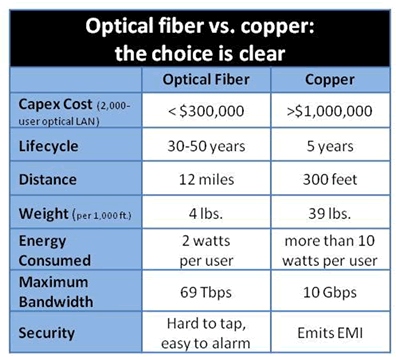Passive Optical Network Solutions for the Department of Defense
The Department of Defense needs to deliver greater network speed and capacity with stronger security, all while dealing with ever-leaner budgets. Telos Corporation explains why passive optical network solutions are the answer.
 Passive Optical Network (PON) technology delivers voice, data, and video at terabit speeds with lower costs and greater security, as well as:
Passive Optical Network (PON) technology delivers voice, data, and video at terabit speeds with lower costs and greater security, as well as:
- High security (SIPRNet/NIPRNet)
- Cost-effectiveness (in both building and maintenance)
- Easier installation in garrison and deployed locations
- Massive capacity now and in the future
- Energy-efficient performance
The Department of Defense needs to deliver greater network speed and capacity with stronger security, all while dealing with ever-leaner budgets. Passive optical network technology helps DoD agencies and the armed forces to strike the right balance between price, performance, and security.

In fact, PON helps maximize all three with implementations that cost less to install and maintain, offer greater capacity, and provide SIPRNet security without hardened Protective Distribution Systems (PDS). Already proven by all branches of the military and the intelligence community, PON technology enables the convergence of voice, data, and video on a single digital network while simplifying installation and consuming fewer resources.
The benefits of PON for the Department of Defense include:
Lower Costs in the Face of Declining Budgets
PON technology can reduce capital expenses by up to 50%, reduce power consumption by as much as 80%, and floor and closet requirements by up to 90%. Optical fiber is also an infrastructure investment that lasts for decades, not just years.
Convergence of Voice, Data, and Video Over One Network
Single-mode optical fiber can support speeds up to 69 terabytes per second (Tb/s) compared with 10Gb/s for Cat6 cabling. That’s sufficient capacity to meet the most ambitious communications strategy, eliminating the need for separate lines for voice, data, and video services.
Integrates with Legacy IT Environments
DoD IT environments frequently include a variety of security standards and heterogeneous networking technologies. These include tactical mesh wireless, Suite B, EoIP, and others. PON integrates smoothly and cleanly with existing networking modalities to preserve the investment in legacy networks and systems.
Ease of Installation
Optical fiber cable is slimmer, easier to handle, and easier to pull and bend than copper cable for easier installation in both garrison and deployed locations. You can also enable multiple security classifications – for example, SIPR and NIPR – to run through the same conduit.
Energy-Efficient Performance
PON can save nearly 60KW over copper for a 700-user LAN, resulting in savings of more than $150,000 per year. PON also provides network power to VoIP phones and wireless access points (WAPs), eliminating the need to plug Ethernet-based appliances into a traditional wall outlet. All this can help conserve precious energy for deployed forces and help DoD agencies meet Executive Order 13423, which requires them to reduce energy intensity by 30%.
Information Security – An Essential Element of Secure PON Solutions
Since the events on 9/11, there has been an exponential growth in the demand for access to classified information. Traditional secure solutions such as SCIF construction, hardened carrier protective distribution systems (PDS), and desktop encryption devices have proven to be very expensive and costly to manage.
Secure PON solutions answer these challenges:
- SIPRNet-level security — PON has been certified by Joint Interoperability Test Command (JITC) for use in SIPRNet environments when used in conjunction with an alarmed fiber PDS solution. When combined with interlocking alarmed fiber and an alarm management system, PON helps agencies comply with NSTISSI no. 7003 guidance for Protective Distribution Systems (PDS).
- Ideal for SCIFs and similar secure facilities — When combined with an alarmed PDS, PON networks can be secured without visual inspection. Cables can be installed within ceilings and floors rather than on exterior walls for even greater security and more aesthetic appeal.
- Resistant to physical taps and jamming — While no network medium is completely impervious to intrusion, optical fiber cables are difficult to tap and are resistant to radio frequency interference and jamming.
[hr]
Telos Corporation provides enterprise solutions to defense and civilian agencies of the federal government, the intelligence community, all branches of the armed forces, and commercial enterprises such as healthcare providers and financial services firms.




